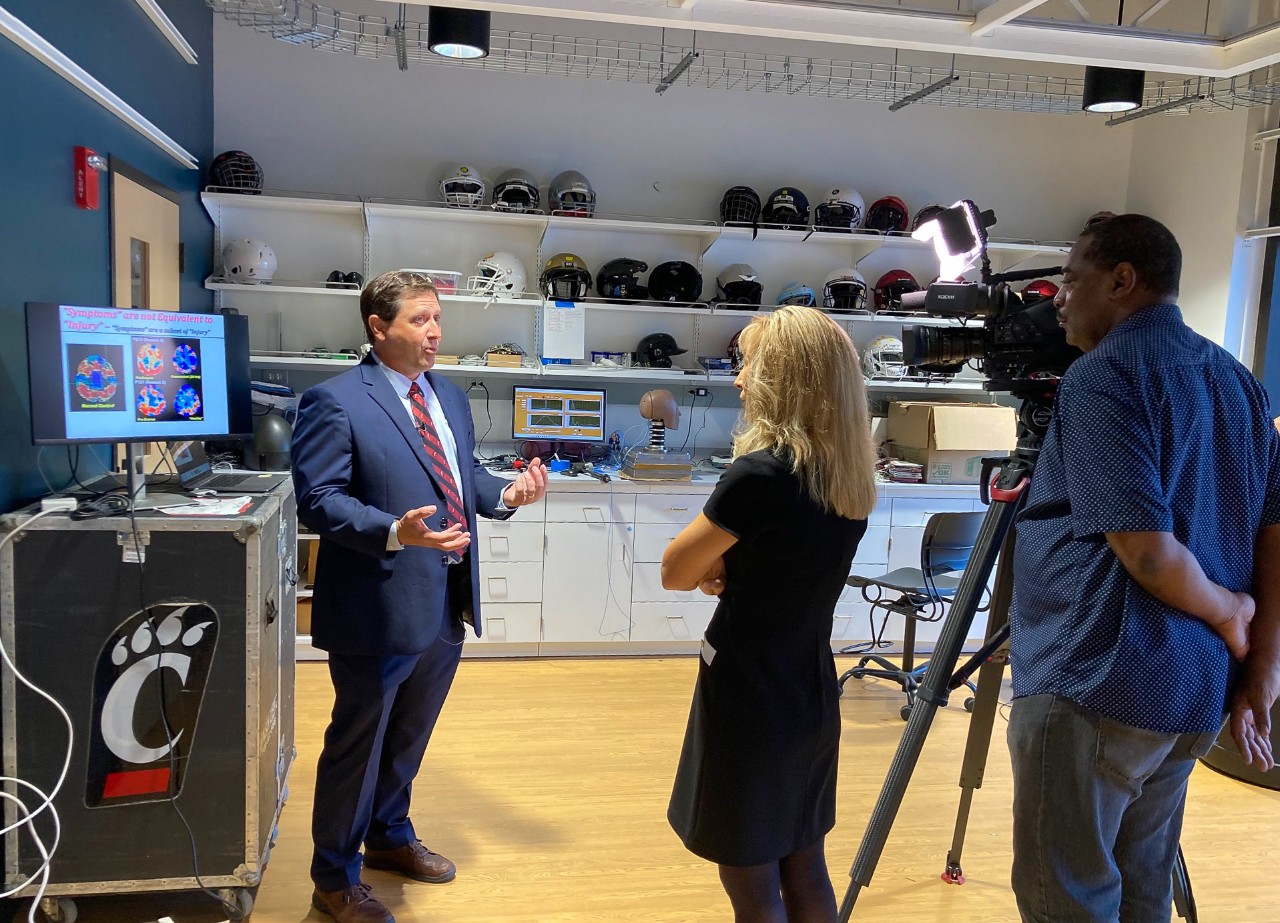
How well does 'collar' work to protect athletes?
UC biomedical engineering researchers study ways to prevent sports concussions
The Washington Post talked to a University of Cincinnati biomedical engineering professor about a sports neck collar designed to protect the brain.
UC College of Engineering and Applied Science Professor Tom Talavage was a consultant for Q30 Innovations, maker of the Q-collar that many athletes wear to prevent brain injuries from tackles, collisions or blows to the head.

Biomedical engineering students put helmets to the test at UC's Bioscience Center. Photo/Andrew Higley/UC
Reviewers with the U.S. Food and Drug Administration examined whether the collar's springy metal can prevent concussions by applying pressure to the jugular vein to restrict the flow of blood in the skull. The company added language to its manual stating that it does not prevent concussions or long-term cognitive problems, the Post said.
More than 280,000 children are treated for sports-related concussions in U.S. emergency rooms each year. But federal health officials say children sustain as many as 3.8 million concussions from sports each year.
Talavage said he is interested in exploring injuries that can occur from smaller, repetitive blows along with the catastrophic head blows that lead to visits to the emergency room.
Talavage and his research partners are looking for ways to improve sports equipment, including helmets, to prevent traumatic brain injuries.
Talavage, who heads UC's Department of Biomedical Engineering, told the Post that he believes the Q-collar does provide some preventive benefits. But he added that the company might be overstating the conclusions of researchers.
“We can’t make the argument that the collar prevents concussion, but it might take longer or be less likely if you use it,” he said.
Talavage studies the brains of high school football players who are subjected to repeated subconcussive blows from blocks, tackles and hitting the ground. Talavage said athletes who wore the Q-collar showed meaningfully less evidence of inflammation from taking these smaller but repetitive blows.
“I think the collar is doing something, and it’s probably doing something that is good,” Talavage told the Post. ”But I would not say it is proven to protect the brain from injury.”
Read the Washington Post story.
Featured image at top: UC Professor Tom Talavage talks to Local 12 reporters at UC's Bioscience Center. Photo/Michael Miller

UC Professor Tom Talavage is studying ways to prevent concussions in sports. Photo/Andrew Higley/UC
Related Stories
Sugar overload killing hearts
November 10, 2025
Two in five people will be told they have diabetes during their lifetime. And people who have diabetes are twice as likely to develop heart disease. One of the deadliest dangers? Diabetic cardiomyopathy. But groundbreaking University of Cincinnati research hopes to stop and even reverse the damage before it’s too late.
Is going nuclear the solution to Ohio’s energy costs?
November 10, 2025
The Ohio Capital Journal recently reported that as energy prices continue to climb, economists are weighing the benefits of going nuclear to curb costs. The publication dove into a Scioto Analysis survey of 18 economists to weigh the pros and cons of nuclear energy. One economist featured was Iryna Topolyan, PhD, professor of economics at the Carl H. Lindner College of Business.
App turns smartwatch into detector of structural heart disease
November 10, 2025
An app that uses an AI model to read a single-lead ECG from a smartwatch can detect structural heart disease, researchers reported at the 2025 Scientific Sessions of the American Heart Association. Although the technology requires further validation, researchers said it could help improve the identification of patients with heart failure, valvular conditions and left ventricular hypertrophy before they become symptomatic, which could improve the prognosis for people with these conditions.
